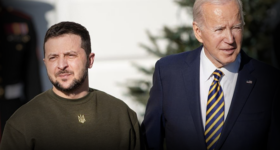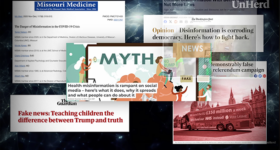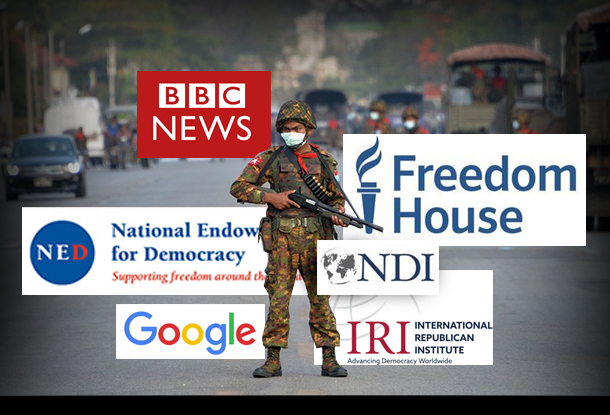
Brian Berletic
21st Century Wire
The age-old adage of history repeating itself because of a collective failure to learn from history’s lessons rings true yet again.
In so many ways, this current situation in Asia reflects the early stages of the Arab Spring. In recent years, political instability has gradually been building in key strategic parts of Asia, accompanied by political pressure from Western powers and familiar calls for intervention to ‘protect the people and restore democracy.’ This is happening alongside increasingly hostile Western rhetoric towards China. As Western media influence continues building across Southeast Asia, so do opposition movements funded and directed by Washington and its allies.
In this analysis, we will compare the geopolitical moves and motivations which drove the Arab Spring with those now unfolding in Asia.
Green Shoots of the Arab Spring
The 2011 US-engineered “Arab Spring” was one of the largest and most ambitious attempts at region-wide geopolitical reordering since the Second World War. It engulfed a region stretching from North Africa, across the Levant, to the Middle East and even into Central Asia.
It involved opposition groups trained, funded, and equipped by the US government and adjacent Western corporations including social media and tech giants like Facebook and Google – years before the first protests began in 2011.
The New York Times in its April 2011 article, “U.S. Groups Helped Nurture Arab Uprisings,” would admit:
A number of the groups and individuals directly involved in the revolts and reforms sweeping the region, including the April 6 Youth Movement in Egypt, the Bahrain Center for Human Rights and grass-roots activists like Entsar Qadhi, a youth leader in Yemen, received training and financing from groups like the International Republican Institute, the National Democratic Institute and Freedom House, a nonprofit human rights organization based in Washington.
The International Republican Institute, National Democratic Institute, and Freedom House are all in turn subsidiaries of the National Endowment for Democracy (NED) – described by the NYT as:
…set up in 1983 to channel grants for promoting democracy in developing nations. The National Endowment receives about $100 million annually from Congress. Freedom House also gets the bulk of its money from the American government, mainly from the State Department.
Evidence of this training can be traced back to as early as 2008 where the above-mentioned April 6 Youth Movement and others were hosted in New York City at the inaugural “Alliance of Youth Movements (AYM) summit sponsored by the US State Department, Google, Facebook, MSNBC, YouTube, CBS News, and Columbia Law School.
Preparations for the 2011 Arab Spring also included the cultivation of heavily armed militant groups who were meant to exploit the unrest being engineered across the region.
Signs were clearly visible as early as 2007, like with veteran journalist Seymour Hersh’s article, “The Redirection: Is the Administration’s new policy benefitting our enemies in the war on terrorism?” which warned of US support for the very extremists that would “rise” up out of the Arab Spring chaos.
Hersh would warn specifically that (emphasis added):
To undermine Iran, which is predominantly Shiite, the Bush Administration has decided, in effect, to reconfigure its priorities in the Middle East. In Lebanon, the Administration has coöperated with Saudi Arabia’s government, which is Sunni, in clandestine operations that are intended to weaken Hezbollah, the Shiite organization that is backed by Iran. The U.S. has also taken part in clandestine operations aimed at Iran and its ally Syria. A by-product of these activities has been the bolstering of Sunni extremist groups that espouse a militant vision of Islam and are hostile to America and sympathetic to Al Qaeda.
While the US and its regional allies would feign surprise and alarm over the rise of extremist militant factions across North Africa and the Middle East from 2011 onward – it was always a very deliberate part of the plan, laid out years before it ever unfolded.
The protests – led by US-funded, trained, and equipped political opposition groups – led to violence deliberately mischaracterized by Western-funded fronts posing as human rights advocacy groups. The violence served as a pretext for the introduction of militant groups openly backed by the US and its allies which then served as a pretext for direct Western military intervention under the pretext of “Responsibility to Protect” also known as “R2P.”
The result of the Arab Spring and subsequent US military interventions was the complete destruction of Libya, the near complete destruction of Syria, enduring political instability in Tunisia and Egypt, the rendering of Yemen into what the UN now considers the worst humanitarian crisis on Earth today, as well as spill over of extremism and violence across North Africa and the Middle East, including the rise of the so-called “Islamic State” and its persistence for years in Syria and Iraq.
The chaos triggered by the US-engineered Arab Spring has served as a pretext for a continued US military presence across a region of the planet spanning North Africa, the Middle East, and Central Asia.
All of this context is important to understand – the use of Western-backed political opposition groups, the use of fronts posing as human rights advocacy groups, Western-sponsored militant groups – in understanding the next destructive chapter of US-driven, region-wide geopolitical reordering – this time unfolding across Asia.
Asia: Arab Spring Redux
The US-engineered Arab Spring was the culmination of Near East geopolitical ambitions best summarized by retired US Army General Wesley Clark in a series of talks and in his memoirs, describing Washington’s drive to achieve global hegemony after the collapse of the Soviet Union, before any other global rival could rise in its place.
In his 2007 article for Salon, “Seven countries in five years,” writer Joe Conason would explain:
Clark’s book also describes a telling encounter nearly a decade earlier with neoconservative eminence Paul Wolfowitz, the former deputy secretary of defense under Rumsfeld who resigned under a cloud of scandal from the World Bank last spring. In May 1991, according to Clark, he dropped in for a conversation with Wolfowitz, then the third-ranking civilian in the Pentagon, to congratulate him on the success of the Gulf War.
“We screwed up and left Saddam Hussein in power. The president [then George H.W. Bush] believes he’ll be overthrown by his own people, but I rather doubt it,” he quotes Wolfowitz lamenting. “But we did learn one thing that’s very important. With the end of the Cold War, we can now use our military with impunity. The Soviets won’t come in to block us. And we’ve got five, maybe 10, years to clean up these old Soviet surrogate regimes like Iraq and Syria before the next superpower emerges to challenge us … We could have a little more time, but no one really knows.”
And through the Arab Spring, this is precisely what the US attempted to achieve.
If the Arab Spring, which began in 2011, was aimed at denying a reemerging Russia or a rising China access to the nations of North Africa and the Middle East as viable partners and allies – then it is all but certain that a new wave of US-backed political subversion will hit Asia, and aimed directly at China itself. This is part of a decades-long US strategy to encircle and contain China’s rise.
The Vietnam War fought between the 1950’s and 1970’s was not only an attempt to maintain Western hegemony over Indochina and contain Soviet inflence, but admittedly an attempt to ultimately encircle and contain China. Within the so-called “Pentagon Papers” released in 1969, it was revealed that the conflict was one part of a greater strategy aimed at containing and controlling China.
Three important quotes from these papers reveal this strategy. It states first that:
…the February decision to bomb North Vietnam and the July approval of Phase I deployments make sense only if they are in support of a long-run United States policy to contain China.
It also claims:
China—like Germany in 1917, like Germany in the West and Japan in the East in the late 30′s, and like the USSR in 1947—looms as a major power threatening to undercut our importance and effectiveness in the world and, more remotely but more menacingly, to organize all of Asia against us.
Finally, it outlines the immense regional theater the US was engaged in against China at the time by stating:
…there are three fronts to a long-run effort to contain China (realizing that the USSR “contains” China on the north and northwest): (a) the Japan-Korea front; (b) the India-Pakistan front; and (c) the Southeast Asia front.
The Pentagon Papers provide for us today the context with which to properly view current tensions in the Indo-Pacific region between the US and China – with the papers’ contents being echoed in more recent documents like the 2021 “U.S. Strategic Framework for the Indo-Pacific” (PDF) focused on maintaining “U.S. strategic primacy in the Indo-Pacific region.”
It is clear what the US seeks to accomplish in the Indo-Pacific region vis-a-vis China. It is also clear how far short the US has come to actually accomplishing this.
While the nations of Asia had at one point counted the US and other Western nations as prominent if not primary trade partners in past decades – today this has changed entirely.
China is the largest trade partner of nearly every nation in Asia – including Japan and South Korea – two supposedly stalwart US allies. The nations of Southeast Asia count China as their largest trade partner, investor, and more recently one of the region’s largest arms suppliers.
China is also building region-spanning infrastructure projects ranging from ports, pipelines, and highways, to a high-speed railway that will connect China’s southern city of Kunming to Laos, and Thailand.
Beyond China’s growing relationships, influence, and strength within Asia, it is also building ties beyond the region, with Russia, nations in the Middle East, Europe, Africa, as well as Central and South America. Hence, in terms of encircling and containing China – the US appears to have failed.
In a bid to reverse this failure, the US has resorted to increasingly aggressive – if not desperate measures. This includes attempts to trigger a regional “spring” in the same fashion the US divided and destroyed the regions of North Africa and the Middle East.
Within China in places like Hong Kong, Taiwan, Xinjiang, and Tibet, the US is backing separatists, violent protests, and even terrorism.
Along China’s peripheries, opposition movements from Thailand and Malaysia, to Cambodia, Laos, the Philippines, and Vietnam – and now Myanmar – seek to either destabilize and destroy Asia’s prosperity to spite a rising China, or turn the region entirely against China.
Through the National Endowment for Democracy, entire political parties and street movements have been created as fifth columns, to be turned against targeted nations, their governments, and their institutions.
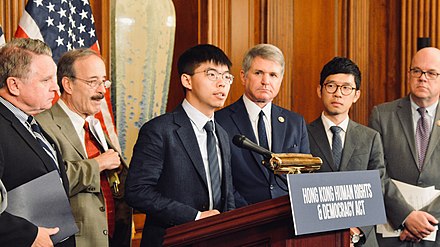
Activist Joshua Wong in Washington, used by US legislators as the face of the Hong Kong Human Rights and Democracy Act (2019)
While the US has attempted to deny any role in political unrest across the region, it has already openly backed violent riots in Hong Kong which culminated with protest leaders like Joshua Wong finally flying to Washington D.C. to appeal directly to the US government for wider and more direct support, albeit too late. Protesters were lauded by US Senators and Congressman and given a platform to speak directly with US legislators.
Numerous other similar opposition-building operations for other Asian nations are also underway.
For Cambodia, the political opposition is literally based in Washington D.C.
Protests in Thailand aimed at ousting the current government and undermining and removing the constitutional monarchy – an institution that has unified and protected Thailand against Western imperialism for centuries – was quietly funded and supported via the National Endowment for Democracy for years, and eventually openly backed by a US Senate resolution late last year.
In each of these countries – China, Cambodia, and Thailand, US-backed subversion has been more or less supported and managed remotely.
However, the real danger now lies in Myanmar, a key Southeast Asian country sharing a border with China, Thailand, Bangladesh, India, and Laos.
Asia’s Libya: Myanmar
Myanmar has suffered for decades since declaring its independence from the British Empire – undermined by a combination of armed ethnic groups backed by the West and a growing army of fronts posing as “nongovernmental organizations” creating a parallel government within Myanmar’s own borders – a parallel government that had begun easily engineering elections, had full control of the media, and began working its way into virtually every other aspect of independent Myanmar’s internal political and economic affairs in a process that could more simply be described as Myanmar’s recolonization.
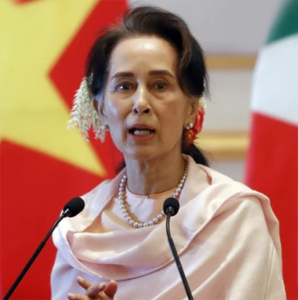 The political opposition in Myanmar is led by Aung San Suu Kyi (image, left) and her National League for Democracy (NLD) party. Once feted by the West as an icon of democracy and awarded a Nobel Peace Prize, she is now a target of Western political and media institutions, with some accusing her of being party to genocide in Myanmar.
The political opposition in Myanmar is led by Aung San Suu Kyi (image, left) and her National League for Democracy (NLD) party. Once feted by the West as an icon of democracy and awarded a Nobel Peace Prize, she is now a target of Western political and media institutions, with some accusing her of being party to genocide in Myanmar.
Suu Kyi herself has personally travelled to Washington DC and London on multiple occasions, has received in person awards from the US National Endowment for Democracy – which funds and directs the vast political network supporting her and her NLD party. She has also attended NED events to award and encourage others carrying out political subversion in Myanmar.
Indeed, some analysts have pointed out how Western pressure placed on Suu Kyi in recent years since taking power in 2015 – claiming she had begun pivoting Myanmar toward China, but this is only half the picture.
Suu Kyi’s cooperation with China and Myanmar’s powerful, independent military was a pragmatic move, and not necessarily an ideological one. Her obedience to the West was ultimately limited by the lack of alternatives the West could offer Myanmar in terms of economic ties, the construction of essential infrastructure, and other areas of national development Myanmar sorely lacks after decades of sociopolitical instability.
Western pressure was aimed at shaping Suu Kyi’s policies – not ousting her or her NLD party from power. Part of this pressure included helping exacerbate the Rohingya Crisis in Myanmar’s southwest Rakhine state. This crisis was deliberately created and fuelled on both sides by Western funding to disrupt Chinese infrastructure projects being built in this region as part of Beijing’s One Belt, One Road initiative. Similar ethnic violence throughout the country has served as cover for attacking Chinese investments in Myanmar.
While this pressure was placed on Suu Kyi, her party and the vast network of faux-NGOs supporting it, remained fully funded and backed by the US and its allies through the NED – which to this day still funds well over 80 projects that are admitted to, and many more that are not admitted to.
A military takeover of the nation’s government earlier this year aimed at uprooting this malign influence.
It triggered violent protests across the country carried out by Suu Kyi’s NLD party and the army of fronts funded by the West through organizations like the NED, Open Society, and the British government.
Just as was done across the Arab World during the 2011 “Arab Spring,” the Western media and an army of faux-human rights advocacy groups report only one side of the story – portraying the violence as solely carried out by government security forces – either not explaining the deaths of police and soldiers – or failing to mention these deaths entirely.
A parallel government led by NLD members who escaped arrest has been created in territory held by Western-backed militant groups who have stepped up armed violence against Myanmar’s military since the recent takeover.
US-funded fronts like the “Karenni Information Center” have reported on armed factions taking over military outposts, capturing prisoners, and seizing arms and equipment – in a fashion eerily similar to how the chaos that consumed Libya began in 2011.
Dubious human rights advocacy groups like the Assistance Association for Political Prisoners (AAPP) are regularly and uncritically cited by the Western media regarding death and detainment tallies – with no mention made that AAPP’s founder and joint secretary, Ko Bo Kyi, is a US NED “fellow” and his organization itself is a beneficiary of NED support.
Other organizations like “Myanmar Now” – an alleged “independent news agency” operating in Myanmar, along with The Irrawaddy, Democratic Voice of Burma (DVB), and many others are also all funded by the US government via the NED.
Much of this funding is not transparently listed on the US NED’s webpage for Myanmar. For example – Myanmar Now’s US NED funding was instead revealed in an older article published by the Columbia Journalism Review, 19 paragraphs in, where it claimed:
Myanmar Now, which receives funding from the National Endowment for Democracy, prides itself on unflinching coverage of crimes against the Rohingya, dissidents, and the poor, and it is widely read by foreigners working inside the country.
This lack of transparency is meant to preserve the illusion of independence and legitimacy of an opposition movement entirely dependent on and directed by Washington and its allies – just as was the case in the early phases of the Arab Spring in 2011.
Western influence throughout the media across Southeast Asia – and its investments in opposition groups in neighboring countries is helping add weight to the propaganda regarding Myanmar’s growing political crisis. Political momentum to stampede Myanmar’s current government out of power is building, while the West and its networks in the region continue placing pressure on ASEAN to abandon its principles of non-interference and intervene in Myanmar.
Within Myanmar, the opposition is openly invoking the “responsibility to protect” – US NED-funded media platforms like the Irrawaddy regularly publish op-eds calling for foreign intervention and “responsibility to protect” by name. Responsibility to protect was the geopolitical ploy used by US policymakers to justify its military intervention in Libya in 2011 – which led directly to the nation’s complete and permanent destruction ever since.
In addition to protesters in the streets demanding Western intervention under the guise of “R2P” and US-funded media platforms calling for it in their columns – Western propagandists are dusting off another gimmick used widely throughout the Arab Spring and subsequent US military interventions – the use of children to plead for intervention.
May Wong, a correspondent for Singapore-based Channel News Asia, shamelessly helped promote a mother exploiting her 9 year old daughter whom she claimed wrote a letter to the UN asking “can you help my country?”
This media campaign is reminiscent of the notorious Bana of Aleppo campaign which was used to promote Western military intervention in Syria.
Perhaps Wong would have served the public better had she rhetorically suggested Serbia, Afghanistan, Iraq, Libya, or Syria, as an answer the girl’s question – pointing out that everywhere the UN helps “authorize” intervention, Washington’s war machine follows – making even the worst accusations made against supposed dictatorships fond memories in comparison to the systematic destruction that soon follows.
Has the World Learned Anything From the Arab Spring?
What’s perhaps most disturbing is that many of the “activists” involved both in the streets of Asia and across the region’s information space – regularly and enthusiastically invoke the notion of an “Asian Spring.” This is in apparent oblivion to how the Arab Spring of 2011 devolved into chaos, violence, war, the destruction of nations, and the destabilization of regions.
Governments across Asia also appear unprepared – particularly for the accompanying information warfare that comes with US political subversion and Washington’s attempts to repeat in Myanmar what it had done in Libya and partially did in Syria.
Thailand, for example, is already facing an influx of refugees fleeing the violence in Myanmar. Yet, state-funded media like Thai PBS (already infiltrated by Western-educated Thais who lean West in their reporting) continue repeating uncritical narratives identical to that of Western media organizations and various Western-funded opposition groups inside Myanmar itself.
In essence, many working across Asia’s information space are throwing fuel into a fire that is set to burn down the entire region.
In some cases, those promoting Western narratives regarding Myanmar, and backing other Washington-sponsored opposition groups throughout Asia, do so deliberately because they themselves are funded by or associated with the US and its allies.
However, if governments, media outlets, and institutions across the region not linked to or part of Western interference in the region fail to summon the courage to work against the powerful pressure placed on them by Western embassies, Western media outlets, faux-rights groups funded by the West, and Western-backed opposition groups – Asia will see history repeat itself again – starting in Myanmar, before seeing instability spreading over Thailand’s borders, and potentially inviting foreign intervention, placing Western troops directly on China’s borders and tipping off a dangerous confrontation that could last years or even decades.
This would compound the slow economic recovery of the region following the COVID-19 economic crisis and mire Asia in the sort of destructive conflicts that have set the Middle East and its respective nations back decades.
As an empire in terminal decline, the US appears to operate under the notion that if it cannot have the Indo-Pacific region – then no one else will either. Just as it continues to spite Russia and Iran in Syria by blocking reconstruction after more than a decade of destructive proxy warfare waged against Damascus, the US is now positioned to replicate this pattern in Asia.
If this situation comes to pass, then history may judge Asia’s leaders harshly, not only for allowing a prosperous region be turned into chaos by foreign interference it failed to prepare for, stand up to, manage, and uproot – but also and perhaps especially because Asia’s leaders were not paying attention and thus failed to learn the lessons from the Arab Spring and guard their people against its inevitable arrival in Asia.
China, for its part, has recently announced close cooperation with Russia and in particular against “color revolutions.” Surely there is common ground there, with other nations facing the common threat of color revolutions sponsored by the West – who can join Moscow and Beijing with urgent efforts required in order to address the mounting chaos in Myanmar, as well as less-intense but still dangerous sedition being sponsored in neighboring Thailand and beyond.
Ultimately, the US is not simply targeting Russia and China with color revolution tactics – but nations all along their respective peripheries. The US and its allies have long worked closely together to foster chaos and conflict around the globe, and perhaps it is time for those nations, governments and individuals being targeted to work in closer cooperation to achieve collective stability.
***
Author Brian Berletic, formerly known under his pen name “Tony Cartalucci,” is Bangkok-based geopolitical researcher, writer and special contributor to 21st Century Wire. See more of his work at Tony’s archive. Over the last decade, his work has been published on a number of popular news and analysis websites, and also on the online magazine “New Eastern Outlook”. Also, you can follow him on VK here.
READ MORE CHINA NEWS AT: 21st Century Wire China Files
PLEASE HELP SUPPORT OUR INDEPENDENT MEDIA PLATFORM HERE





